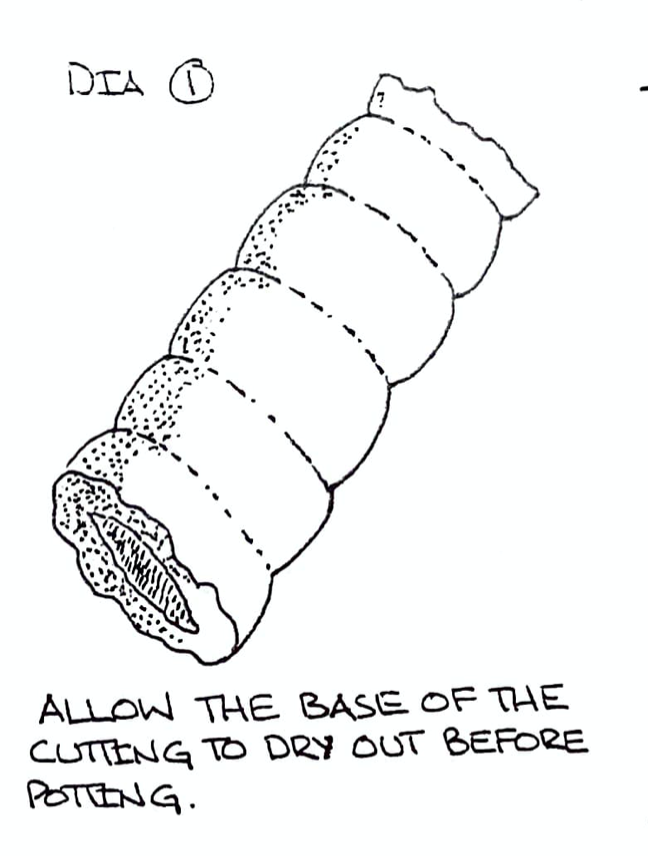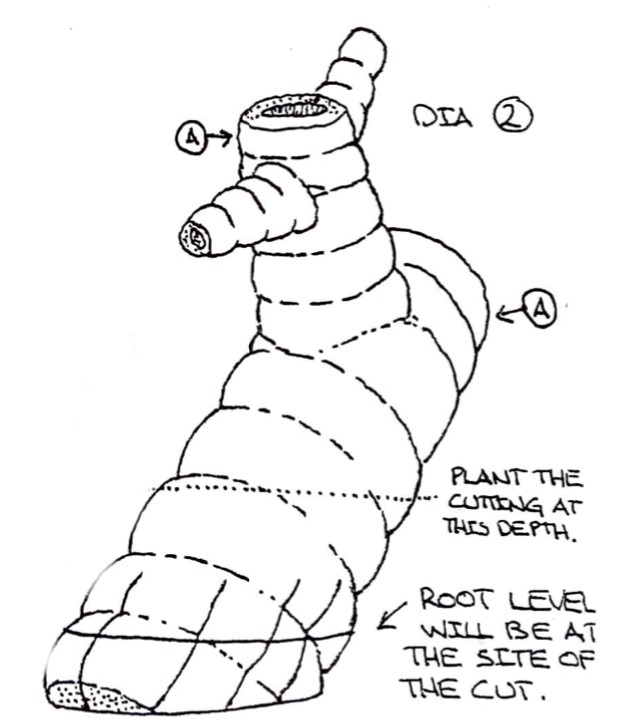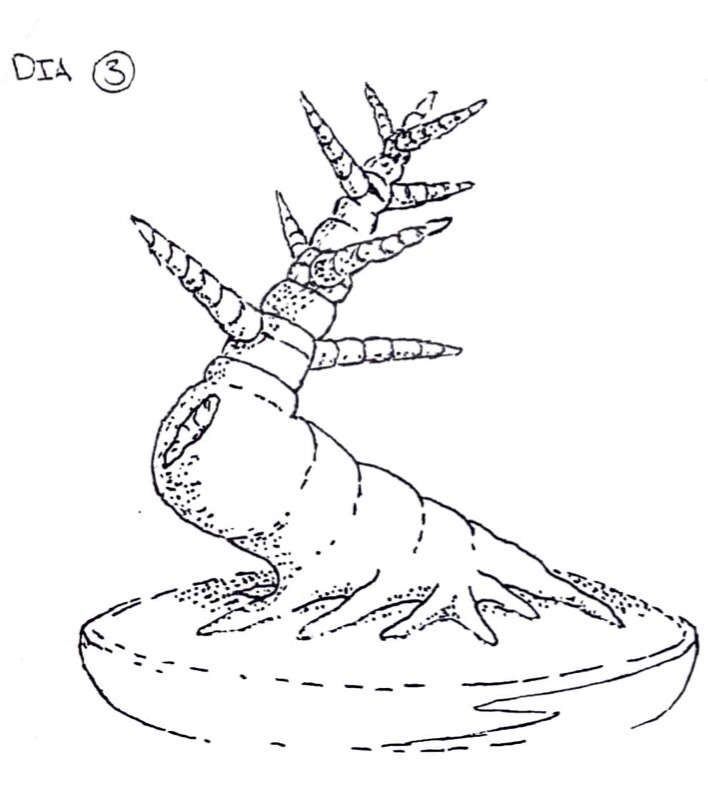 When jade is taken as cuttings, it’s very important to remember that you are dealing with a succulent. If the base of the cutting is not allowed to dry out for a few days the inner wood can rot out before roots emerge. This usually results in either total loss of the cutting or damage that undermines the characteristics possessed by the material. If cuttings are taken and planted straight away, the best approach is to plant them into just moist, well drained potting mix and don’t water until new growth appears. In cooler months, this can take 6-8 weeks.
When jade is taken as cuttings, it’s very important to remember that you are dealing with a succulent. If the base of the cutting is not allowed to dry out for a few days the inner wood can rot out before roots emerge. This usually results in either total loss of the cutting or damage that undermines the characteristics possessed by the material. If cuttings are taken and planted straight away, the best approach is to plant them into just moist, well drained potting mix and don’t water until new growth appears. In cooler months, this can take 6-8 weeks.
 THE JANET SABEY METHOD
THE JANET SABEY METHOD
There is a technique that you can use to produce a radiating root system on jade. When you find an interesting piece of ‘wood’ you will want the cutting to produce an even root system. Make a series of deep cuts which penetrate all the way to the heart wood. These cuts are made longways and are spaced evenly around the base of the cutting. Once the cuts have been completed, make a cut around the base at the angle that will give you the best nebari at the required planting angle.
Note: Leave excess length (A) as a certain amount of drying out will occur and the segmented growth of the jade can be removed after new growth appears.
 Jade has a growth habit that is not what we bonsai people like. Branches appear in pairs along the main stems. They also appear from the side and top, as well as below the branch. This symmetrical growth has to be controlled by pruning, if a natural branch framework is to be achieved.
Jade has a growth habit that is not what we bonsai people like. Branches appear in pairs along the main stems. They also appear from the side and top, as well as below the branch. This symmetrical growth has to be controlled by pruning, if a natural branch framework is to be achieved.
 The easiest way to cure the problem of symmetry is to prune irregularity into the tree until a realistic framework is achieved. Once the basic shape is produced, the foliage mass can be developed on one or two seasons.
The easiest way to cure the problem of symmetry is to prune irregularity into the tree until a realistic framework is achieved. Once the basic shape is produced, the foliage mass can be developed on one or two seasons.
Note: The trick, if that’s the correct word, is to start the tree with as large a cutting as you would like the tree to be. Although the tree continues to increase in size during its life, it is easier to begin with a piece of material that is already advanced. Because of the ease of propagation, jade can be approached in the opposite way to most other plant varieties/ species. The only real restriction is the size to the material you can get your hands on.
REPOTTING
Jade should be repotted in the warmer months. They enjoy a tight root-ball, so repotting is not done too often. You should also keep an eye on watering after the tree has be repotted as the roots can rot easily, if correct after care is not given.
What I Do
The best way to approach any technique is with advice from someone who has done it. The problem is that most people who get advice, use it as some kind of guarantee to be produced, if, and when the ‘poo impacts with climate control’. Always consider the time of year, temperature and aftercare rather than what is possible if all the planets line up. Everything is at one with itself. Cold, damp weather and succulent varieties of plants do not mix. Rot can set in and drying times are much longer in cooler months than during our summers. If you have a plant type that is basically a big water bottle and you devastate the root system, in theory, it should contain enough moisture within its trunk, branches and leaves to hold it over until the roots recover.
Apply this same thinking most of the other types of plants that we impose our will upon and you will understand why some things that are ‘tough’ at certain times, faulter or fail when touched at others.
Regardless of what time of year it is, I take cuttings and root prune with little or no loss. My climate is from -3°C to 48°C and I am able to handle jade successfully because I only ever use soil that is well drained and only one step from dry. In winter, this will allow the cutting to develop its roots in an environment that is warm, rather than cold and wet. In summer, the heat will force the cutting or newly root pruned plant to issue roots quickly in order to compensate for the loss the plant is experiencing due to the warmer temperatures. Regardless of whether it is a cutting or established plant, I never water until I see new growth. If it takes a week or a month, I only water when new growth appears. This sometimes means that the leaves will shrivel and fall but have faith, the plant will recover.
Once the plant or cutting is growing well, I treat it like any other plant in the nursery. They get full sun, lots of fertiliser and regular water.
SHAPING AND DEVELOPMENT
Once you get a jade growing, it can produce huge amounts of branches as well as leaves. You can control quite a bit with pruning and pinching but wiring is the real answer.
Jade takes a while to set into shape, which is a problem when dealing with other species (removing the wire before it cuts in, only to find the plant needs to be rewired). Not jade, the wirease can be left on until it bites deeply and when it’s finally removed, the growth segments pump up and the cuts disappear. Magic!
Now, there may be lots of different times that this plant can be defoliated, but I do it in summer. I make sure the tree is in tiptop health and in full sun. The tree buds from everywhere and the leaves are tiny. I only do this on trees that are basically framed. If the branch layout is good with many zigzag branchlets, then defoliation will produce foliage mass in no time. To defoliate before the branches are built is pointless. Defoliation also allows the grower to remove any rogue growth that develops undetected.
Note: The main reason I grow jade, apart from the lush green healthy colour, is that it is the only tree that I can grow happily on or over a rock. I’ve grown jade in one season that were fat and branched well. To achieve the same stature and development in an elm, maple or even a fig would take many years.
I’m not putting jade above these other plants but I’m certainly not putting it below either. However, long our climate continues to create difficulty in growing the types of plants we are told make good bonsai, I will grow jade. It’s nice to have a few varieties in my collection that perform regardless of the type of weather we are experiencing. Jade is, as yet, not treated seriously. I think that given the same attention as the more mainstream species, jade could be a great addition to bonsai. It’s long-lived, propagates easily, buds on old wood, transplants well, can be grown in all styles and handles all but the coldest climates with less water than you can believe. How hard is that?
